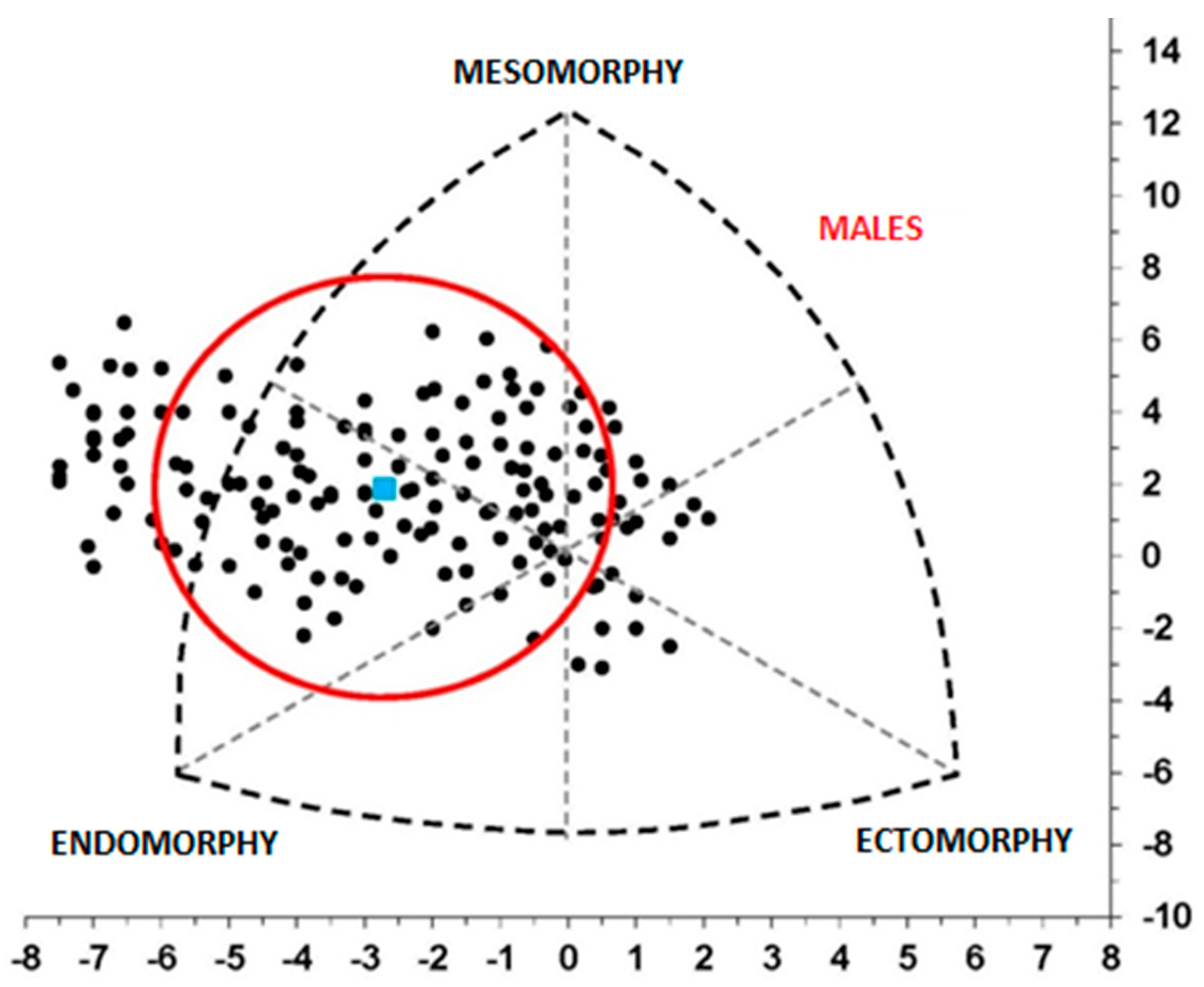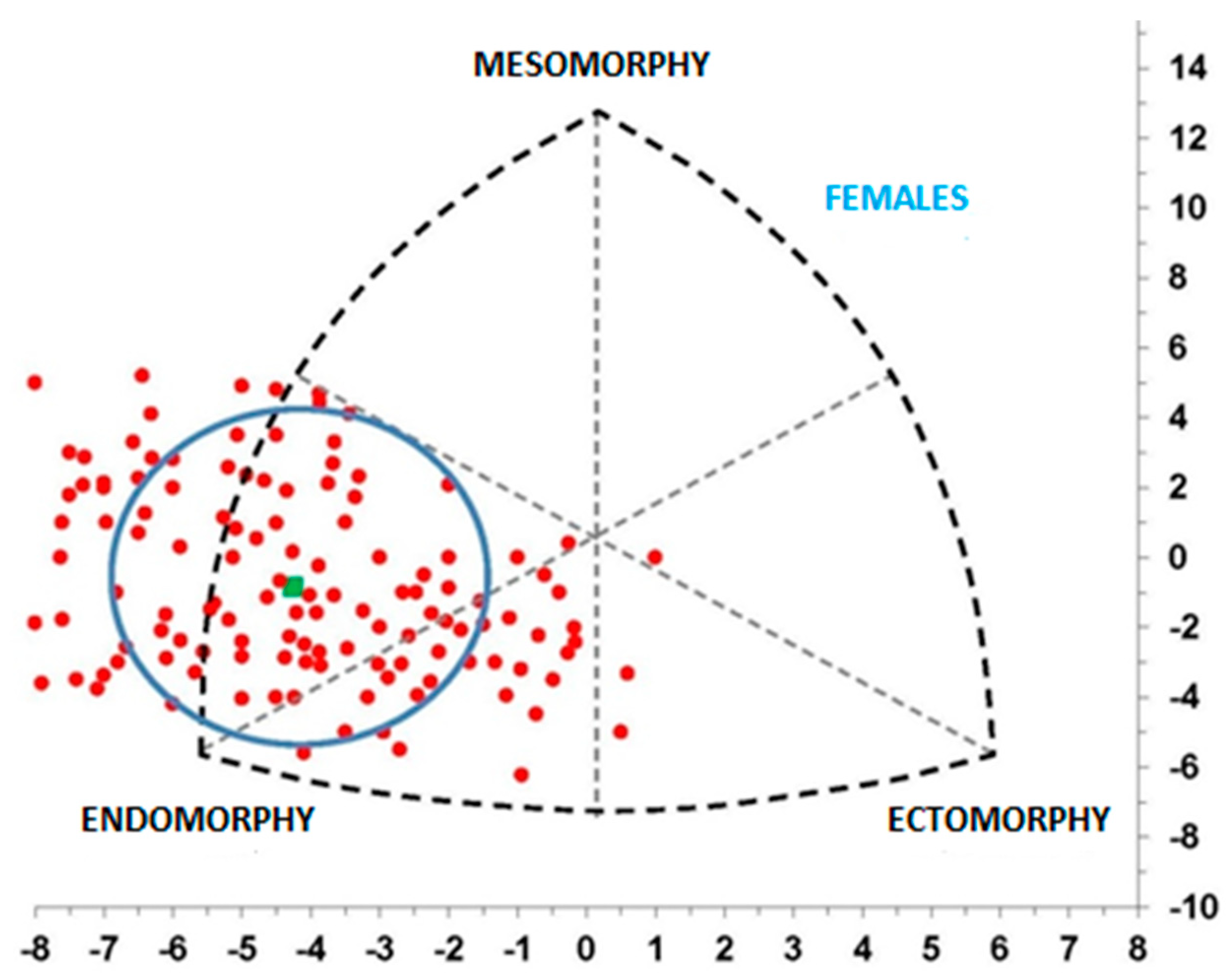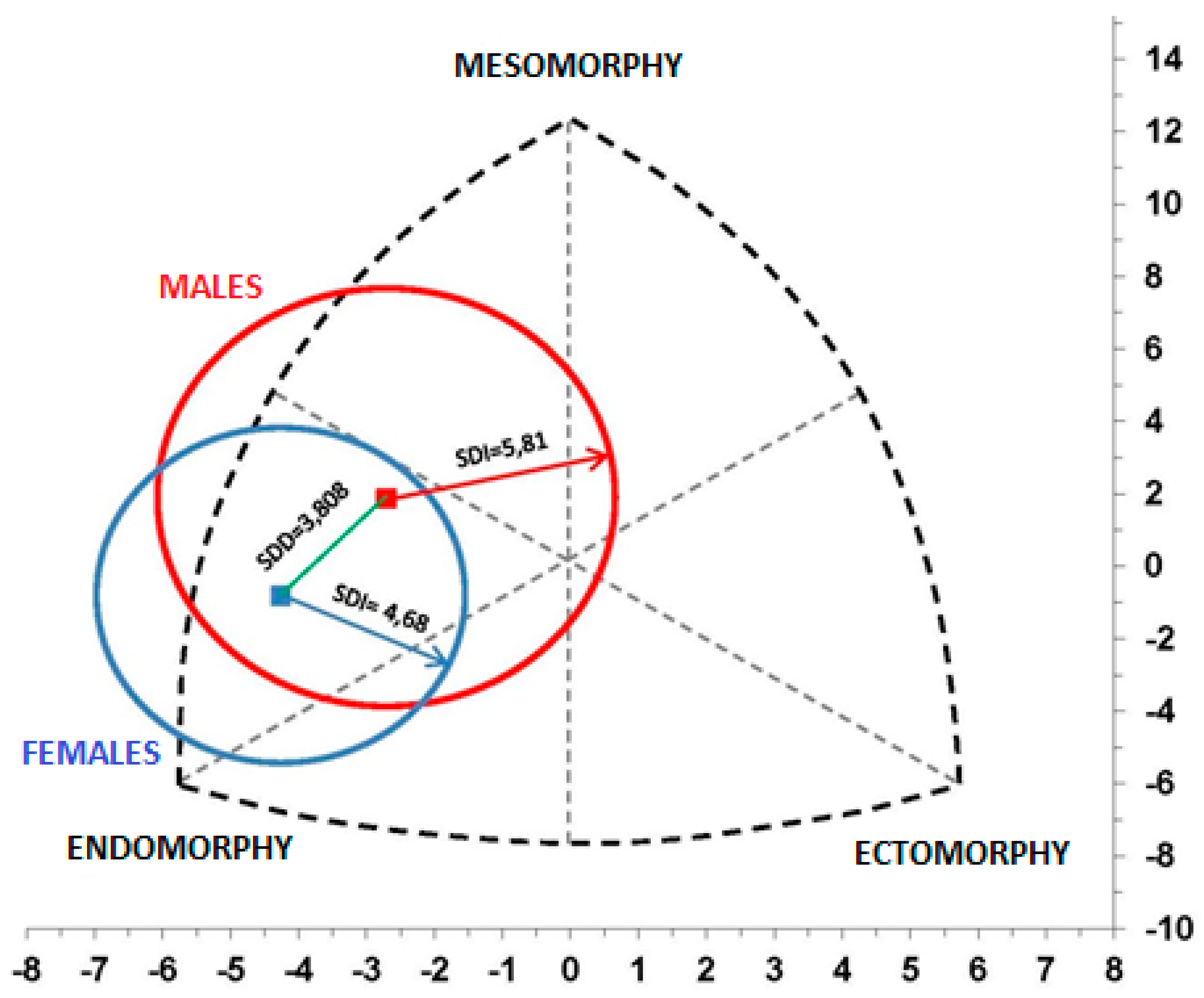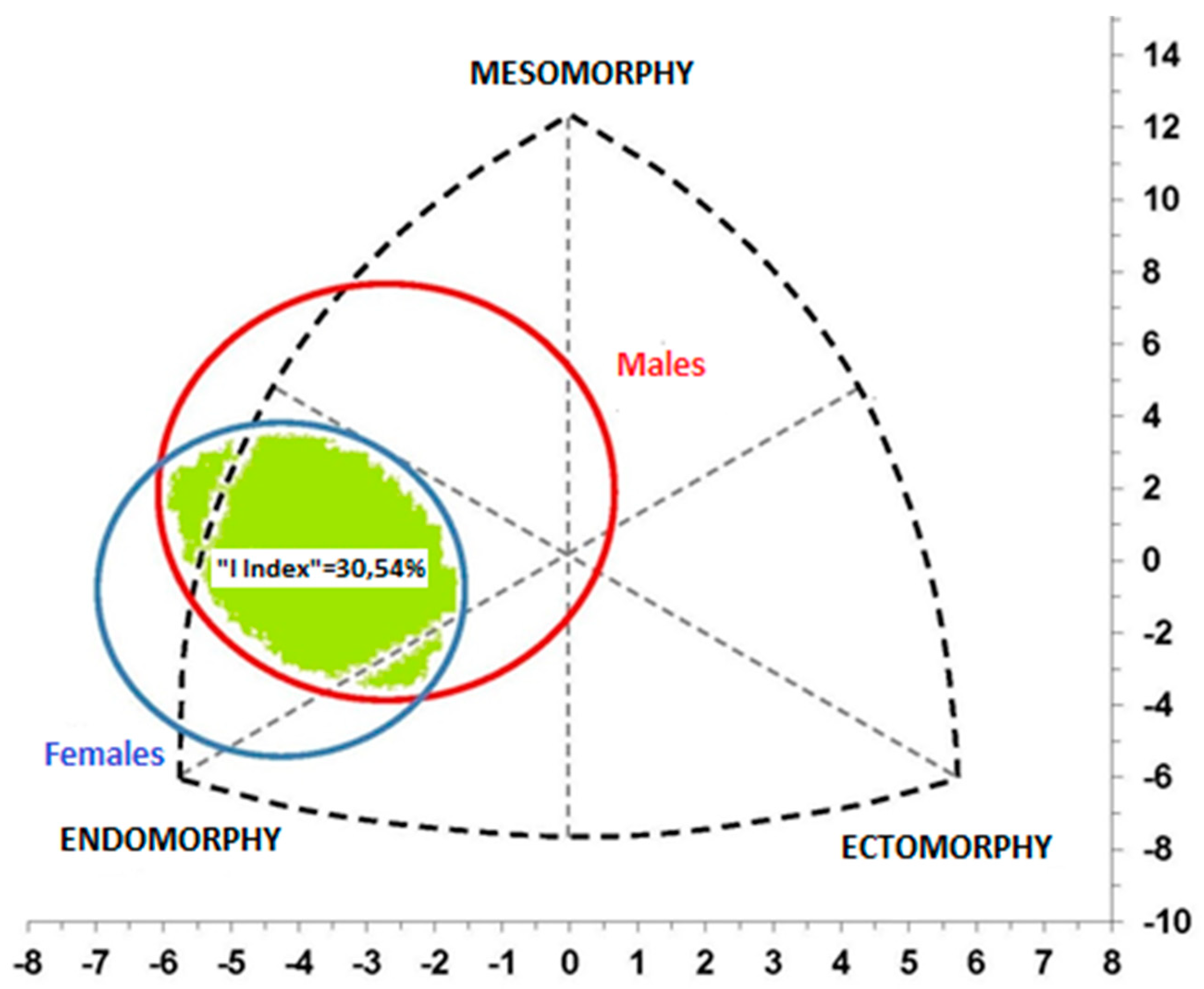Somatotype, BMI, and Sexual Dimorphism in Adolescent School Sports Players in Peru
Abstract
1. Introduction
2. Materials and Methods
2.1. Design
2.2. Participants
2.3. Instruments
2.4. Procedure
3. Results
4. Discussion
5. Conclusions
Author Contributions
Funding
Acknowledgments
Conflicts of Interest
References
- Lozano-Rojas, G.; Cabello-Morales, E.; Hernández-Díaz, H.; Loza-Munarriz, C. Prevalencia de peso y obesidad en adolescentes de un distrito urbano de Lima. Rev. Peru Med. Exp. Salud Publ. 2014, 31, 494–500. [Google Scholar]
- Flores-Rivera, J.A. Perfil cineantropométrico de la selección peruana de judo Infantil, Juvenil, Junior, Mayores; Universidad Nacional Mayor de San Marcos: Lima, Peru, 2009. [Google Scholar]
- Silva, H.; Bruneau, J.C.; Reyno, H.P.; Bucarey, S. Somatotipo e índice de masa corporal en una muestra de adolescentes de ambos sexos de la ciudad de Temuco, Chile. Int. J. Morphol. 2003, 21, 309–313. [Google Scholar] [CrossRef]
- Silva, M.H.; Collipal, L.E.; Martínez, C.; Torres, I. Análisis del IMC, somatotipo en una muestra de adolescentes con sobrepeso y obesidad en Temuco-Chile. Int. J. Morphol. 2008, 26, 707–711. [Google Scholar] [CrossRef]
- Godoy-Cumillaf, E.A.R.; Valdés-Badilla, P.A.; Salvador, S.N.; Carmona-López, M.I.; Fernández, J.J. Anthropometric characteristics of adolescents from different sports training schools. Int. J. Morphol. 2015, 33, 1065–1070. [Google Scholar] [CrossRef]
- Irrutia-Amigo, A.; Busquets-Faciaben, A.; Marina-Evrard, M.; Galilea-Ballarini, P.A.; Carrasco-Marginet, M. Talla, peso, somatotipo y composición corporal en gimnastas de elite españoles desde la infancia hasta la edad adulta. Apunts. Medicina de l’Esport 2009, 44, 18–28. [Google Scholar] [CrossRef]
- Menezes, L.S.; Novaes, J.; Fernández-Filho, J. Somatotipo de atletas y practicantes de gimnasia rítmica prepubescentes y postpubescentes. Int. J. Morphol. 2014, 32, 968–972. [Google Scholar] [CrossRef]
- Torres, F.J.; Lara-Padilla, E.; Sosea-Tattei, G.; Berral, F.J. Análisis de composición corporal y somatotipo de judokas infantiles y cadetes en el campeonato de España 2012. Int. J. Morphol. 2014, 32, 194–201. [Google Scholar] [CrossRef]
- De los Santos, J.; Ghioldi, M.; Obeid, M.D.; Schattner, C. Características antropométricas y hábitos alimentarios de estudiantes de danza clásica, Instituto Superior de Arte del Teatro Colón. Apunts. Medicina de l’Esport 2016, 51, 85–92. [Google Scholar] [CrossRef]
- Montecinos, R.; Valdés, R.; Guajardo, J. Somatotipo de escolares de 9 a 12 años de edad. Apunts. Medicina de l’Esport 1981, 18, 69–74. [Google Scholar]
- De Onis, M.; Onyango, A.W.; Borghi, E.; Siyam, A.; Nashidaa, C.; Siekmanna, J. Elaboración de un patrón OMS de crecimiento de escolares y adolescentes. Bull. World Health Organ. 2007, 85, 660–667. [Google Scholar] [CrossRef]
- Cabañas-Armesilla, M.D. Características antropométricas generales. Valoración del tamaño corporal; Cabañas-Armesilla, M.D., Esparza-Ros, F., Eds.; Compendio de Cineantropometría, CTO Editorial: Madrid, Spain, 2009. [Google Scholar]
- Valdés-Badilla, P.; Salvador Soler, N.; Godoy-Cumillaf, A.; Carmona-López, M.I.; Fernández, J.J.; Durán-Agüero, S. Somatotipo, estado nutricional y nivel de glucemia de estudiantes de educación física. Nutr. Hosp. 2015, 32, 1261–1266. [Google Scholar] [CrossRef] [PubMed]
- Marfell-Jones, M.; Olds, T.; Stewart, A.; Carter, J.E.L. International Standards for Anthropometric Assessment; ISAK: Potchefstroom, South Africa, 2006. [Google Scholar]
- Rosique, J. Estudio transversal del crecimiento en escolares vizcaínos. Ph.D. Thesis, Universidad del País Vasco-Euskal Herriko Unibertsitatea, Bilbao, Spain, 1992. [Google Scholar]
- Carter, J.E.L.; Heath, B.H. Somatotyping—Development and Applications; Cambridge University Press: Cambridge, UK, 1990. [Google Scholar]
- Duquet, W.; Carter, J.E.L. Kinanthropometry and Execirse Physiology Laboratory Manual: Test Procedures and Data, 3rd ed.; Reilly, T., Eston, R.G., Eds.; Routledge: London, UK, 2009; pp. 52–72. [Google Scholar]
- Ross, W.D.; Wilson, N.C. A somatotype dispersión index. Res. Quart. 1973, 44, 372–374. [Google Scholar] [CrossRef]
- Hebbelinck, M.; Carter, J.E.L.; De Garay, A. Body Built and Somatotipe of Olimpic Swimmers. In Swimmer II; Lewille, L., Clays, J.P., Eds.; University Park: Baltimore, MD, USA, 1975. [Google Scholar]
- Ross, W.D. Metaphorical Models in the Study of Human Shape and Proportionality. In Physical Education, Sports and the Sciences; Broekhoeff, J., Ed.; Microcard Publications: La Crosse, WI, USA, 1976; pp. 284–304. [Google Scholar]
- Cahuana-Rios, E.; Taipe-Aylas, M. Somatotipo y su relación con el estado nutricional en escolares limeños de 12 a 16 años. Casus. Revista de Investigación y Casos en Salud 2016, 1, 27–33. [Google Scholar]
- Álvarez-Dongo, D.; Sánchez-Abanto, J.; Gómez-Guizado, G.; Tarqui-Mamani, C. Sobrepeso y obesidad: Prevalencia y determinantes sociales del exceso de peso en una población peruana 2009–2010. Rev. Peru Med. Exp. Salud Públ. 2012, 29, 303–313. [Google Scholar]
- Aguilar-Cordero, M.J.; González-Jiménez, E.; García-García, C.J.; García-López, P.A.; Álvarez-Ferre, J.; Padilla-López, C.A.; González-Mendoza, J.L.; Ocete-Hita, E. Obesidad de una población de escolares de Granada: Evaluación de la eficacia de una intervención educativa. Nutr. Hosp. 2011, 26, 636–641. [Google Scholar] [CrossRef]
- Martínez, C.; Silva, H.; Collipal, E.; Carrasco, V. Description of somatotype and BMI the adolescent’s sample to pubic school of the Temuco-Chile. Int. J. Morphol. 2008, 26, 653–657. [Google Scholar] [CrossRef]
- Kovalskys, I.; Bay, L.; Rausch Herscovici, C.; Berner, E. Prevalencia de obesidad en una población de 10 a 19 años en la consulta pediátrica. Rev. Chil. Pediatric 2005, 76, 324–325. [Google Scholar] [CrossRef]
- Pajuelo-Ramírez, J. La obesidad en el Perú. Fac. Med. 2017, 78, 179–185. [Google Scholar] [CrossRef][Green Version]
- Rivera, J.; González, T.; Pedraza, S.; Aburto, T.; Sánchez, T.; Martorell, R. Childhood and adolescent overweight and obesity in Latin America: Asystematic review. Lancet Diabetes Endocrinol. 2014, 2, 321–332. [Google Scholar] [CrossRef]
- Gómez-Campos, R.; Hespanhol, J.E.; Arruda, M.; Abella, C.-P.; Fargueta, M.; Cossio-Bolanos, M.A. Valoración del crecimiento físico por medio de la proporcionalidad corporal en escolares peruanos que viven a moderada altitud. Rev. Bras Cineantropom Desempenho Hum. 2012, 14, 690–703. [Google Scholar]
- Ruderman, A.; Navarro, T.; Mangeaud, A.; Cejas, V.; Bajo, J.M. Somatotipo de adolescentes escolarizados de Córdoba (Argentina). Rev. Argent. Antropol. Biológica 2017, 19, 1–11. [Google Scholar] [CrossRef]
- Subramanian, S.K.; Vivek-Kumar, S.; Vinayathan, A.; Krishnakumar, R.; Rajendran, R. Somatotyping in adolescents: Stratified by sex and physical activity. Int. J. Anat. Appl. Physiol. 2016, 2, 32–38. [Google Scholar]
- Inuka-Gakhar, S. Age changes and sex differences in somatotypes among Jats of Delhi. Anthropol. Spec. 2002, 1, 115–125. [Google Scholar] [CrossRef]
- Rebato, E.; Rosique, J. Estudio del somatotipo en la comarca de Busturia. Cuad. Secc. Antrop. 1994, 12, 11–77. [Google Scholar] [CrossRef]
- González-Montero, M.; Marrodán-Serrano, M.D. La salud escolar también se mide. Guía práctica para el docente. Cuadernos de innovación; Centro Regional de Innovación y Formación “Las Acacias”: Madrid, Spain, 2007. [Google Scholar]
- Rebato, E.; Muñoz-Cañón, M. Influencia del estatus socioeconómico (SES) sobre la variabilidad antropométrica en estudiantes universitarios del país Vasco (España). Rev. Arg. Antropol. Biol. 2016, 18, 1–11. [Google Scholar] [CrossRef]
- Bodzsár, É.B.; Susanne, C. Données récentes concernant les variations de somatotypes entre 7 et 18 ans au sein de la population hongroise. Bull. Mém. Soc. Anthropol. Paris 1999, 11, 333–348. [Google Scholar] [CrossRef]




| Basic Measures | Skinfold Measures | Circumference | Diameter | ||||||||
|---|---|---|---|---|---|---|---|---|---|---|---|
| Height | Weight | Triceps | Subscap | Suprsp | Leg | Arm | Leg | BiHum | BiFem | ||
| Overall n = 294 | Mean | 156.71 | 54.98 | 18.38 | 15.03 | 18.11 | 19.62 | 26.65 | 33.23 | 5.92 | 8.77 |
| SD | 8.18 | 10.75 | 7.77 | 7.65 | 9.59 | 9.79 | 3.69 | 3.40 | 0.69 | 0.86 | |
| Max. | 173.72 | 88.88 | 45.45 | 46.46 | 42.42 | 49.49 | 46.46 | 44.44 | 8.69 | 11.11 | |
| Min. | 139.59 | 34.45 | 4.95 | 3.96 | 4.16 | 6.44 | 20.30 | 23.27 | 4.46 | 4.95 | |
| Males n = 165 | Mean | 160.52 | 58.40 | 17.43 | 13.59 | 16.71 | 18.40 | 27.49 | 34.31 | 6.22 | 9.20 |
| SD | 7.87 | 10.80 | 9.12 | 7.73 | 10.43 | 10.20 | 2.73 | 3.22 | 0.60 | 0.72 | |
| Max. | 173.72 | 88.88 | 45.45 | 40.40 | 42.42 | 46.46 | 32.32 | 44.44 | 8.48 | 11.11 | |
| Min. | 141.08 | 36.83 | 4.95 | 3.96 | 4.16 | 6.44 | 20.79 | 27.72 | 4.85 | 5.54 | |
| Females n = 129 | Mean | 151.84 | 50.51 | 19.59 | 16.87 | 19.91 | 21.19 | 25.57 | 31.85 | 5.45 | 8.22 |
| SD | 5.58 | 8.91 | 5.39 | 7.15 | 8.08 | 9.03 | 4.41 | 3.13 | 0.62 | 0.68 | |
| Max. | 169.68 | 77.77 | 37.37 | 46.46 | 40.40 | 49.49 | 46.46 | 39.39 | 8.69 | 9.70 | |
| Min. | 139.59 | 34.45 | 10.40 | 7.92 | 7.92 | 9.90 | 20.30 | 23.27 | 4.46 | 4.95 | |
| Males Vs. Females | Z | −8.892 | −6.429 | −4.075 | −5.326 | −3.832 | −3.467 | −6.544 | −6.192 | −9.770 | −11.71 |
| Sig. | 0.000 *** | 0.000 *** | 0.000 *** | 0.000 *** | 0.000 *** | 0.001 ** | 0.000 *** | 0.000 *** | 0.000 *** | 0.000 *** | |
| Somatotype Components | Somatoc. Coordinates | ||||||
|---|---|---|---|---|---|---|---|
| BMI | Endomorphy | Mesomorphy | Ectomorphy | X | Y | ||
| Overall n = 294 | Mean | 22.31 | 5.38 | 4.02 | 1.98 | −3.39 | 0.68 |
| SD | 3.67 | 2.10 | 1.33 | 1.30 | 3.20 | 3.07 | |
| Max. | 33.81 | 10.29 | 8.48 | 6.14 | 2.97 | 7.03 | |
| Min. | 16.06 | 1.52 | 0.95 | 0.10 | −10.19 | −8.55 | |
| Males n = 165 | Mean | 22.68 | 4.83 | 4.41 | 2.11 | −2.71 | 1.87 |
| SD | 3.93 | 2.30 | 1.10 | 1.37 | 3.49 | 2.47 | |
| Max. | 33.81 | 10.29 | 7.83 | 6.14 | 2.07 | 6.47 | |
| Min. | 16.06 | 1.52 | 1.13 | 0.10 | −7.50 | −3.10 | |
| Females n = 129 | Mean | 21.84 | 6.08 | 3.53 | 1.82 | −4.26 | −0.83 |
| SD | 3.25 | 1.56 | 1.44 | 1.19 | 2.55 | 3.10 | |
| Max. | 32.17 | 9.91 | 8.48 | 4.23 | 1.02 | 5.20 | |
| Min. | 16.94 | 3.20 | 0.95 | 0.10 | −8.00 | −6.23 | |
| Males Vs. Females | Z | −1.279 | −5.323 | −6.581 | −1.674 | −4.362 | −7.610 |
| Sig. | 0.201 n/s | 0.000 *** | 0.000 *** | 0.094 n/s | 0.000 *** | 0.000 *** | |
| SOMATOCHART ZONE | Females | Males |
|---|---|---|
| Endomorphic zone | 83.72% | 45.45% |
| Endo-mesomorphic zone | 0% | 7.27% |
| Mesomorphic zone | 0% | 23.03% |
| Meso-ectomorphic zone | 0% | 8.48% |
| Ectomorphic zone | 2.32% | 4.64% |
| Ecto-endomorphic zone | 4.24% | 1.82% |
| Central zone | 9.30% | 9.70% |
| Option A: BMI – Somatotype Components (Continuous Values) | Option B: Spearman Rho BMI-Somatotype Categories | |||||
|---|---|---|---|---|---|---|
| Overall | Males | Females | Overall | Males | Females | |
| Endomorphy | 0.697 | 0.761 | 0.703 | −0.461 | −0.648 | −0.233 |
| Mesomorphy | 0.594 | 0.657 | 0.548 | |||
| Ectomorphy | −0.933 | −0.929 | −0.955 | |||
| X coordinate | −0.833 | −0.877 | −0.898 | |||
| Y coordinate | 0.425 | 0.352 | 0.475 | |||
| Mean Somatotype Coordinates | Dispersion Index (SDI) | Distance between Somatotype Means (SDD) | |
|---|---|---|---|
| Male population | X = −2.71; Y = 1.87 | SDI = 5.81 | 3.808 |
| Female population | X = −4.26; Y = −0.83 | SDI = 4.68 | |
| Males Vs. Females | Z = −3.073 | ||
| Sig. = 0.002 *** |
© 2019 by the authors. Licensee MDPI, Basel, Switzerland. This article is an open access article distributed under the terms and conditions of the Creative Commons Attribution (CC BY) license (http://creativecommons.org/licenses/by/4.0/).
Share and Cite
Linares-Manrique, M.; Hernández-Gallardo, D.; Arencibia-Moreno, R.; Rojas-Cabrera, M.; Macedo-Figueroa, J.; Linares-Girela, D. Somatotype, BMI, and Sexual Dimorphism in Adolescent School Sports Players in Peru. Sustainability 2019, 11, 6224. https://doi.org/10.3390/su11226224
Linares-Manrique M, Hernández-Gallardo D, Arencibia-Moreno R, Rojas-Cabrera M, Macedo-Figueroa J, Linares-Girela D. Somatotype, BMI, and Sexual Dimorphism in Adolescent School Sports Players in Peru. Sustainability. 2019; 11(22):6224. https://doi.org/10.3390/su11226224
Chicago/Turabian StyleLinares-Manrique, Marta, Damaris Hernández-Gallardo, Ricardo Arencibia-Moreno, Miguel Rojas-Cabrera, Julio Macedo-Figueroa, and Daniel Linares-Girela. 2019. "Somatotype, BMI, and Sexual Dimorphism in Adolescent School Sports Players in Peru" Sustainability 11, no. 22: 6224. https://doi.org/10.3390/su11226224
APA StyleLinares-Manrique, M., Hernández-Gallardo, D., Arencibia-Moreno, R., Rojas-Cabrera, M., Macedo-Figueroa, J., & Linares-Girela, D. (2019). Somatotype, BMI, and Sexual Dimorphism in Adolescent School Sports Players in Peru. Sustainability, 11(22), 6224. https://doi.org/10.3390/su11226224




